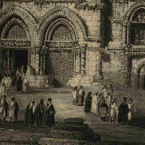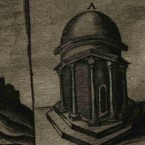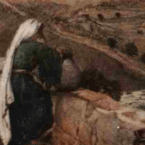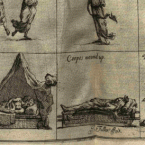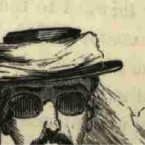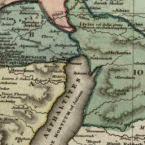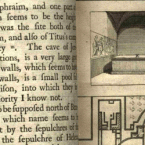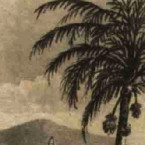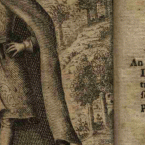Perspectives on Jerusalem
Broadening the study of individual perspective developed in Mobile Subjects to the scale of a city, this case collects books that attempt to situate Jerusalem both within a growing discourse of modern urbanism, and as the scene of multiple perspectives. Cities proliferate perspectives, since they gather more or less diverse people, but also because they create architectural landscapes whose various heights, windows, streetscape canyons, and fresh horizons generate new views. These books map Jerusalem, fit it into the modern print genre of veduti city scenes, and ask whether the city that is so often the focus of attention cast on Palestine is best seen on foot, or from above, in a foldout architectural plan, or a written narrative, from God’s perspective, a traveler’s, or the state’s, inside or outside the Church of the Holy Sepulchre, or from the Mount of Olives. As contemporary Israeli and Palestinian politicians struggle over the landscapes of the ancient city, the unwieldy effort of these books to reconcile myriad perspectives on and of Jerusalem becomes far less past than present.
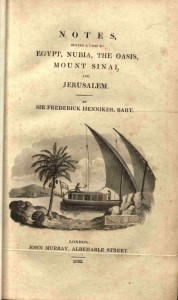
 This gorgeously designed and well-preserved book opens with an aquatint fold-out view of Jerusalem whose precision could let a traveler use it for wayfinding. As with many such views, its caption announces its point of origin: “from the cave of the Apostles on the Mount of Olives.” This disclosure not only increases the information value of the image, since it gives viewers an experience of two places at once, the seen, and the seen-from, but the holiness of the origin point probably also enhances the import and semblance of authority of the view itself. In another noteworthy feature of this book, the conjunctions and juxtapositions of categories in the table of contents offer a touching parable of the collection. Chapter Two, for example promises “Plague… Dogs… Obelisks… Swallows… Copies… Bedoins… Etko… Rosetta Gardens… Bagage… Rice Magazine… Ablutions… Coffee and Pipes… More dogs.” The injunction noted to the binder, meanwhile, that the fold-out view of Jerusalem ought “to face the Title Page” invites the interpretation of the book itself as a map and maze to be journeyed through, deciphered and created as an urbane place for dwelling and wandering.
This gorgeously designed and well-preserved book opens with an aquatint fold-out view of Jerusalem whose precision could let a traveler use it for wayfinding. As with many such views, its caption announces its point of origin: “from the cave of the Apostles on the Mount of Olives.” This disclosure not only increases the information value of the image, since it gives viewers an experience of two places at once, the seen, and the seen-from, but the holiness of the origin point probably also enhances the import and semblance of authority of the view itself. In another noteworthy feature of this book, the conjunctions and juxtapositions of categories in the table of contents offer a touching parable of the collection. Chapter Two, for example promises “Plague… Dogs… Obelisks… Swallows… Copies… Bedoins… Etko… Rosetta Gardens… Bagage… Rice Magazine… Ablutions… Coffee and Pipes… More dogs.” The injunction noted to the binder, meanwhile, that the fold-out view of Jerusalem ought “to face the Title Page” invites the interpretation of the book itself as a map and maze to be journeyed through, deciphered and created as an urbane place for dwelling and wandering.
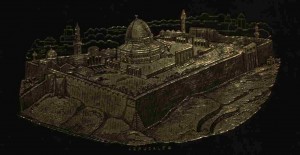
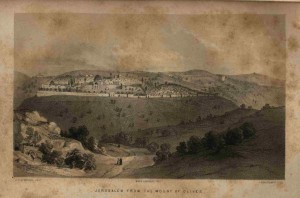 Like a place long overrun by tourists or pilgrims, this book looks older than its age. For books as for places, a semblance of antiquity depends as much on the histories they come captioned with as on the traces of use—of being carried about—that they
Like a place long overrun by tourists or pilgrims, this book looks older than its age. For books as for places, a semblance of antiquity depends as much on the histories they come captioned with as on the traces of use—of being carried about—that they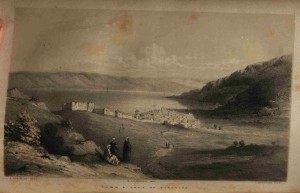 themselves carry. The exceptional lithographic illustrations in this book attend a rather wry authorial voice, most succinctly evinced in the perspective on Jerusalem narrated in the table of contents, “First View of Holy City—Feelings of Disappointment.” Despite Spencer’s disenchantment with Jerusalem, a gold view of the city embosses the cover of his book.
themselves carry. The exceptional lithographic illustrations in this book attend a rather wry authorial voice, most succinctly evinced in the perspective on Jerusalem narrated in the table of contents, “First View of Holy City—Feelings of Disappointment.” Despite Spencer’s disenchantment with Jerusalem, a gold view of the city embosses the cover of his book.
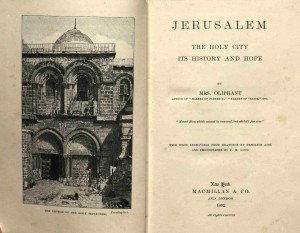 Renowned Victorian author Margaret Oliphant’s account of Jerusalem participates thoroughly in its time, both as a fin-de-siècle observation of a city, and as a designed object. Although halftone photo reproduction processes
Renowned Victorian author Margaret Oliphant’s account of Jerusalem participates thoroughly in its time, both as a fin-de-siècle observation of a city, and as a designed object. Although halftone photo reproduction processes 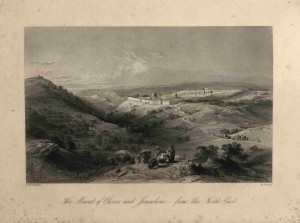 were available, the book includes “wood engravings from drawings and photographs.” This choice of print technique allows all the images to appear under one visual system, but also reissues the preference for older printmaking methods in the visual fashion of the day. As more immediate documents of the region, electrotyped
were available, the book includes “wood engravings from drawings and photographs.” This choice of print technique allows all the images to appear under one visual system, but also reissues the preference for older printmaking methods in the visual fashion of the day. As more immediate documents of the region, electrotyped 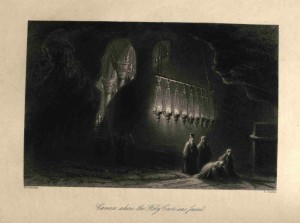 or halftone reproductions of original drawings and photographs of Oliphant’s travels would have brought their own authenticity. According to the bibliographic nostalgia inspired most famously by William Morris’s tireless efforts to propagate the woodcut, however, in the 1890s a certain charm and semblance of authority attended older image reproduction processes like wood engraving. The disjunction between wood engraving, original drawing and photography embedded in Oliphant’s book, therefore, reveals the contest between authority and authenticity that illustration so frequently incites.
or halftone reproductions of original drawings and photographs of Oliphant’s travels would have brought their own authenticity. According to the bibliographic nostalgia inspired most famously by William Morris’s tireless efforts to propagate the woodcut, however, in the 1890s a certain charm and semblance of authority attended older image reproduction processes like wood engraving. The disjunction between wood engraving, original drawing and photography embedded in Oliphant’s book, therefore, reveals the contest between authority and authenticity that illustration so frequently incites.
V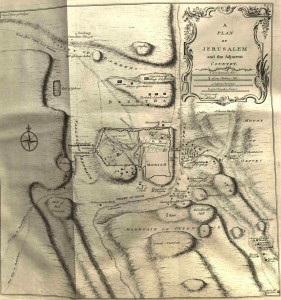 olume Two of Richard
olume Two of Richard 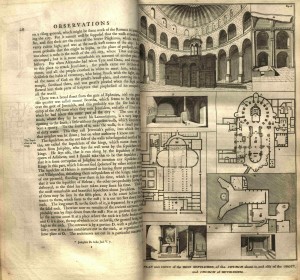 Pococke’s palatial description contains a fold out map of Jerusalem (pictured here), as well as numerous views of key buildings in the city, including an especially thorough revelation of the Church of the Holy Sepulchre. The book combines detailed architectural layouts with interior scenes that are reminiscent of Giovanni Battista Piranesi’s contemporaneous prints of Roman buildings. The title of this section, “Palestine or the Holy Land,” recalls the challenge to nomenclature that the area continues to pose.
Pococke’s palatial description contains a fold out map of Jerusalem (pictured here), as well as numerous views of key buildings in the city, including an especially thorough revelation of the Church of the Holy Sepulchre. The book combines detailed architectural layouts with interior scenes that are reminiscent of Giovanni Battista Piranesi’s contemporaneous prints of Roman buildings. The title of this section, “Palestine or the Holy Land,” recalls the challenge to nomenclature that the area continues to pose.
“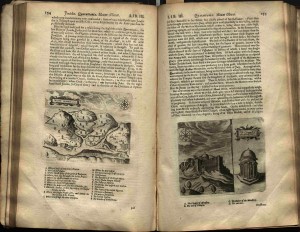 Now we are in the Holy Land,” begins the third book of Sandys’ elegant and slim quarto travels, thus invoking the troubled locatability of books, their readers, and the space between their pages. Sandys proceeds to narrate the history of the region, and a peering protoanthropological discussion of Jews, before delving into an encounter with the region through the events of the New Testament. The chapter’s many unsigned engraved illustrations present multiple views of Jerusalem, and several architectural studies and layouts of key buildings in Christian worship. “Where the apostles did hide themselves” notes a caption to a view of the valley of Jeosaphat (146), “where Christ ascended into Heaven,” reads the first caption on a view of the Mount of Olives. “Where the Angel stood,” marks a spot in an image of the Virgin’s Sepulchre. The promise of geographic precision casts events of faith into fact, in a captioning pas de deux that parallels the epistemology of fiction. Although Sandys does mention the Palestinians (“a warlike and powerful people, of whom afterwards the whole Land of Promise took the name of Palestine” [116]), their treatment is far less extensive than his relatively sympathetic account of Jewish culture, and the illustrations contain few houses and no human figures. Living culture in the Holy Land the illustrations depict is invisible. Interpreting the truth of this emptiness, the lack of inhabitants and habitations, deciding whether it constitutes a false apparition, an evaporation of Palestinian life, or a truthful socio-historical representation of the place generates a series of spectral landscapes. Either the landscape of spiritual history Sandys attempts to reveal is spectral, detached from embodied contemporary experience, or the history of the region as populated itself begins to flicker and threaten to go out.
Now we are in the Holy Land,” begins the third book of Sandys’ elegant and slim quarto travels, thus invoking the troubled locatability of books, their readers, and the space between their pages. Sandys proceeds to narrate the history of the region, and a peering protoanthropological discussion of Jews, before delving into an encounter with the region through the events of the New Testament. The chapter’s many unsigned engraved illustrations present multiple views of Jerusalem, and several architectural studies and layouts of key buildings in Christian worship. “Where the apostles did hide themselves” notes a caption to a view of the valley of Jeosaphat (146), “where Christ ascended into Heaven,” reads the first caption on a view of the Mount of Olives. “Where the Angel stood,” marks a spot in an image of the Virgin’s Sepulchre. The promise of geographic precision casts events of faith into fact, in a captioning pas de deux that parallels the epistemology of fiction. Although Sandys does mention the Palestinians (“a warlike and powerful people, of whom afterwards the whole Land of Promise took the name of Palestine” [116]), their treatment is far less extensive than his relatively sympathetic account of Jewish culture, and the illustrations contain few houses and no human figures. Living culture in the Holy Land the illustrations depict is invisible. Interpreting the truth of this emptiness, the lack of inhabitants and habitations, deciding whether it constitutes a false apparition, an evaporation of Palestinian life, or a truthful socio-historical representation of the place generates a series of spectral landscapes. Either the landscape of spiritual history Sandys attempts to reveal is spectral, detached from embodied contemporary experience, or the history of the region as populated itself begins to flicker and threaten to go out.
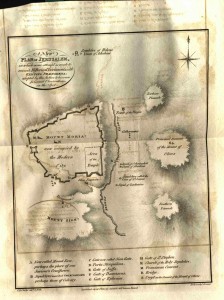 This large multi-volume work contains the first clear reference to a female engraver, who is, unusually, identified with a first as well as last name, as Letitia Byrne in this image she engraved from a drawing by the author himself (426). This book participates quite distinctly in Edward Said’s description of Orientalist productions of knowledge, by mustering authority
This large multi-volume work contains the first clear reference to a female engraver, who is, unusually, identified with a first as well as last name, as Letitia Byrne in this image she engraved from a drawing by the author himself (426). This book participates quite distinctly in Edward Said’s description of Orientalist productions of knowledge, by mustering authority 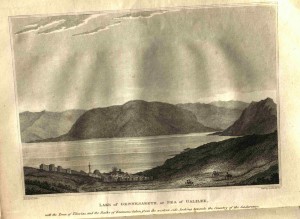 with extensive footnotes, and its large size. Similarly, Clarke’s numerous references to the published travels in the Holy Land of Chateaubriand recall the usual trouble of distinguishing what “place” travelers feel they are visiting—does visiting the Holy Land always entail a sojourn in a text, either the Bible, or the most contemporary Romantic French literature? If this form of excursion should prove more thoroughly informative or pleasurable, then the cultural digression represented by a trip to the Holy Land would be oddly defined by a dalliance with the rival national culture—a short jaunt
with extensive footnotes, and its large size. Similarly, Clarke’s numerous references to the published travels in the Holy Land of Chateaubriand recall the usual trouble of distinguishing what “place” travelers feel they are visiting—does visiting the Holy Land always entail a sojourn in a text, either the Bible, or the most contemporary Romantic French literature? If this form of excursion should prove more thoroughly informative or pleasurable, then the cultural digression represented by a trip to the Holy Land would be oddly defined by a dalliance with the rival national culture—a short jaunt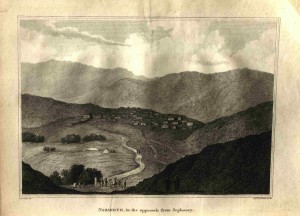 to the Continent (if only in thoughts) rather than a quest to the Orient. Also of note in this book are the careful and specific identifications of the locations generating the perspectives of the illustrations. The scene of Nazareth is subtitled, “in the approach from Sephoury” (462), while the view on the Sea of Galilee is specified as the “Lake of Gennesareth, or the Sea of Galilee, with the town of Tiberius and the baths of Emmaus, taken from the Western side, looking towards the country of the Gadarenes” (426). In another odd and noble gesture that aspires to representational precision, in a map of Jerusalem “some attempt is made to reconcile Historical Documents with existing phenomena” (552).
to the Continent (if only in thoughts) rather than a quest to the Orient. Also of note in this book are the careful and specific identifications of the locations generating the perspectives of the illustrations. The scene of Nazareth is subtitled, “in the approach from Sephoury” (462), while the view on the Sea of Galilee is specified as the “Lake of Gennesareth, or the Sea of Galilee, with the town of Tiberius and the baths of Emmaus, taken from the Western side, looking towards the country of the Gadarenes” (426). In another odd and noble gesture that aspires to representational precision, in a map of Jerusalem “some attempt is made to reconcile Historical Documents with existing phenomena” (552).
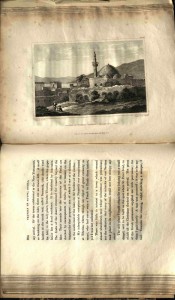 The illustrations in this edition have the fine washes and detailing of the still-novel printmaking technique of aquatint, but were made with the more laborious and imprecise method of engraving. This relation contains a fable of media shift: old media may attain the standards brought by new media, while changes in usage may largely be motivated by efficiency of production rather than novelty of effect. In the notable fold-out frontispiece seen here, “Jerusalem from the Terrace of the Convent of the Latin Monks, looking on the Mount of Olives,” the curious announcement of the location from which this image was taken is especially worth noting. Again, it seems that the relative holiness of the place from which a perspective is taken is as important
The illustrations in this edition have the fine washes and detailing of the still-novel printmaking technique of aquatint, but were made with the more laborious and imprecise method of engraving. This relation contains a fable of media shift: old media may attain the standards brought by new media, while changes in usage may largely be motivated by efficiency of production rather than novelty of effect. In the notable fold-out frontispiece seen here, “Jerusalem from the Terrace of the Convent of the Latin Monks, looking on the Mount of Olives,” the curious announcement of the location from which this image was taken is especially worth noting. Again, it seems that the relative holiness of the place from which a perspective is taken is as important  as what is being looked at. Herein is a moral for the present conflict in the region, and its historiographies: the present and
as what is being looked at. Herein is a moral for the present conflict in the region, and its historiographies: the present and
future you can see depend on the past
you think you’re standing on.
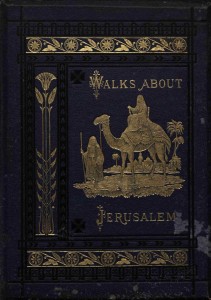 Bartlett’s offering is embossed in gold with the classic British icon of Palestine, a camel and palms. A frontispiece offers a slanted bird’s-eye view of Jerusalem.
Bartlett’s offering is embossed in gold with the classic British icon of Palestine, a camel and palms. A frontispiece offers a slanted bird’s-eye view of Jerusalem. 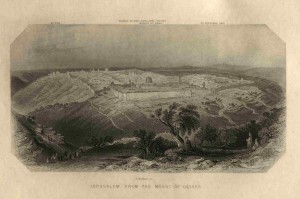 Curiously the bodies of residents appear in these images almost as part of the topography of the city. While the image captioned “Jewish family on Mount Zion” seems to be torn from the pages of a contemporary fashion manual, the one called “Roman & Medieval Masonry” is ostensibly of a crowd of Arab men. This instance of unequal identification represents
Curiously the bodies of residents appear in these images almost as part of the topography of the city. While the image captioned “Jewish family on Mount Zion” seems to be torn from the pages of a contemporary fashion manual, the one called “Roman & Medieval Masonry” is ostensibly of a crowd of Arab men. This instance of unequal identification represents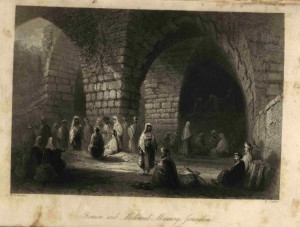 the disappearing of Arab experience that marks the historiography of Palestine in Western hands, and reveals the potentially dishonest gaze of illustration, which can articulate fictional perspectives and glances that lie. Curiously, in
the disappearing of Arab experience that marks the historiography of Palestine in Western hands, and reveals the potentially dishonest gaze of illustration, which can articulate fictional perspectives and glances that lie. Curiously, in
this book that addresses itself to the armchair traveler, Bartlett valorizes walking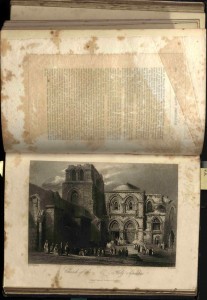 through a city as the prime method
through a city as the prime method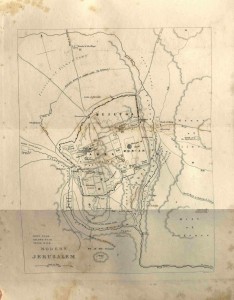 of possessing or knowing it. The book thus participates in the cult of flaneur that Baudelaire was brewing in the same period.
of possessing or knowing it. The book thus participates in the cult of flaneur that Baudelaire was brewing in the same period. 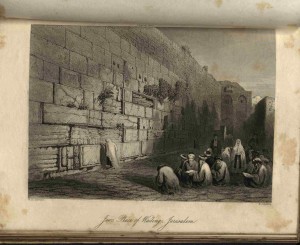 Given the scope of earlier perspectives on Jerusalem this exhibit has amassed (a “desultory” load Bartlett felt, all of which lacked “correct and well-chosen Views”) his ambitions for the book, and his sense of his own originality are worth quoting at length: “no Views of Jerusalem at all valuable for the purpose of topographical or historical illustration have yet appeared,” he writes in his preface,
Given the scope of earlier perspectives on Jerusalem this exhibit has amassed (a “desultory” load Bartlett felt, all of which lacked “correct and well-chosen Views”) his ambitions for the book, and his sense of his own originality are worth quoting at length: “no Views of Jerusalem at all valuable for the purpose of topographical or historical illustration have yet appeared,” he writes in his preface,
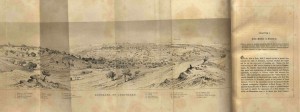 In this, Bartlett’s sequel to Walks about Jerusalem, a fold-out panorama gives a broad view of Jerusalem, while action-based scenes deliver a more photographic atmosphere to his images than was present in his work of a decade before.
In this, Bartlett’s sequel to Walks about Jerusalem, a fold-out panorama gives a broad view of Jerusalem, while action-based scenes deliver a more photographic atmosphere to his images than was present in his work of a decade before.
Last Display Case: Palestine in the World
